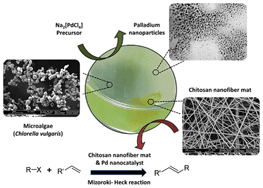Biogenic production of palladium nanocrystals using microalgae and their immobilization on chitosan nanofibers for catalytic applications†
Abstract
Spherical palladium

* Corresponding authors
a
Centre for Strategic Nano-Fabrication, School of Chemistry and Biochemistry, The University of Western Australia, M313, 35 Stirling Highway, Crawley, Australia
E-mail:
colin.raston@uwa.edu.au
Fax: +61 8 6488 8683
Tel: +61 8 6488 3045
b
ARC Centre of Excellence in Plant Energy Biology, The University of Western Australia, M313, 35 Stirling Highway, Crawley, Australia
E-mail:
steven.smith@uwa.edu.au
Fax: +61 8 6488 4401
Tel: +61 8 6488 4403
c School of Chemistry and Biochemistry, The University of Western Australia, 35 Stirling Highway, Crawley, Australia
d Surface Science & Technology Group, School of Chemistry, The University of Melbourne, Australia
Spherical palladium

 Please wait while we load your content...
Something went wrong. Try again?
Please wait while we load your content...
Something went wrong. Try again?
E. Eroglu, X. Chen, M. Bradshaw, V. Agarwal, J. Zou, S. G. Stewart, X. Duan, R. N. Lamb, S. M. Smith, C. L. Raston and K. S. Iyer, RSC Adv., 2013, 3, 1009 DOI: 10.1039/C2RA22402J
To request permission to reproduce material from this article, please go to the Copyright Clearance Center request page.
If you are an author contributing to an RSC publication, you do not need to request permission provided correct acknowledgement is given.
If you are the author of this article, you do not need to request permission to reproduce figures and diagrams provided correct acknowledgement is given. If you want to reproduce the whole article in a third-party publication (excluding your thesis/dissertation for which permission is not required) please go to the Copyright Clearance Center request page.
Read more about how to correctly acknowledge RSC content.
 Fetching data from CrossRef.
Fetching data from CrossRef.
This may take some time to load.
Loading related content
